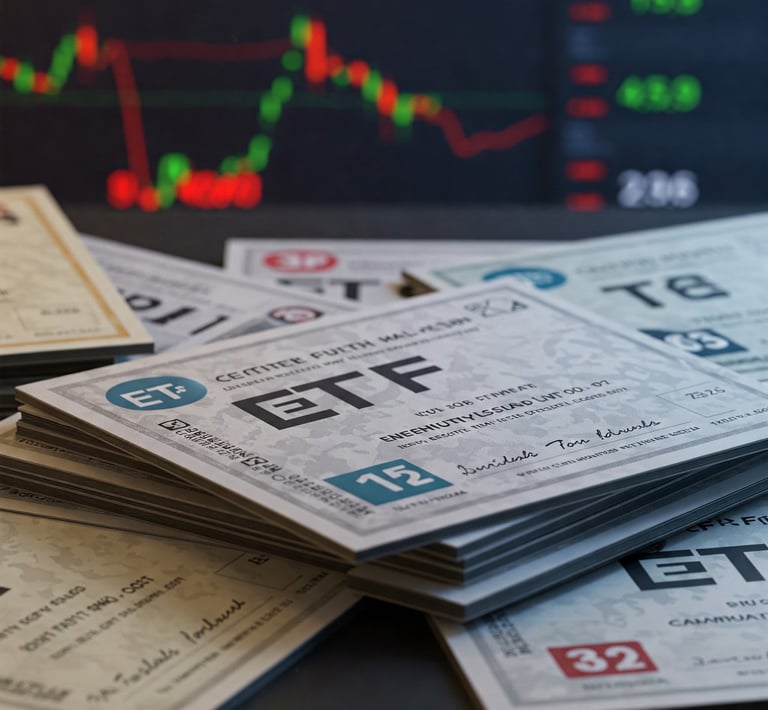

Incorporating ETFs (exchange-traded funds) into your investment strategy offers a range of compelling benefits for both novice and seasoned investors. One of the primary advantages is diversification: a single ETF can provide exposure to a broad mix of assets—such as stocks, bonds, or commodities—eliminating the need to select and manage each security individually. This wide-ranging exposure helps protect your portfolio from significant losses if any one investment underperforms, while still positioning you for robust growth. ETFs also excel in terms of cost efficiency, typically featuring lower management fees than mutual funds, which means more of your money stays invested and working for you, potentially boosting your long-term returns. Their flexibility is another key benefit, as ETFs can be bought and sold throughout the trading day just like stocks, allowing you to respond swiftly to market movements or changes in your personal financial situation. Transparency is also a hallmark of ETFs, with real-time pricing and clear insight into the underlying holdings, so you always know exactly what you own. Additionally, ETFs are often more tax-efficient than mutual funds, as they tend to generate fewer taxable capital gains, helping you retain more of your profits over time.
ETFs
Key Features of ETFs.
Liquidity
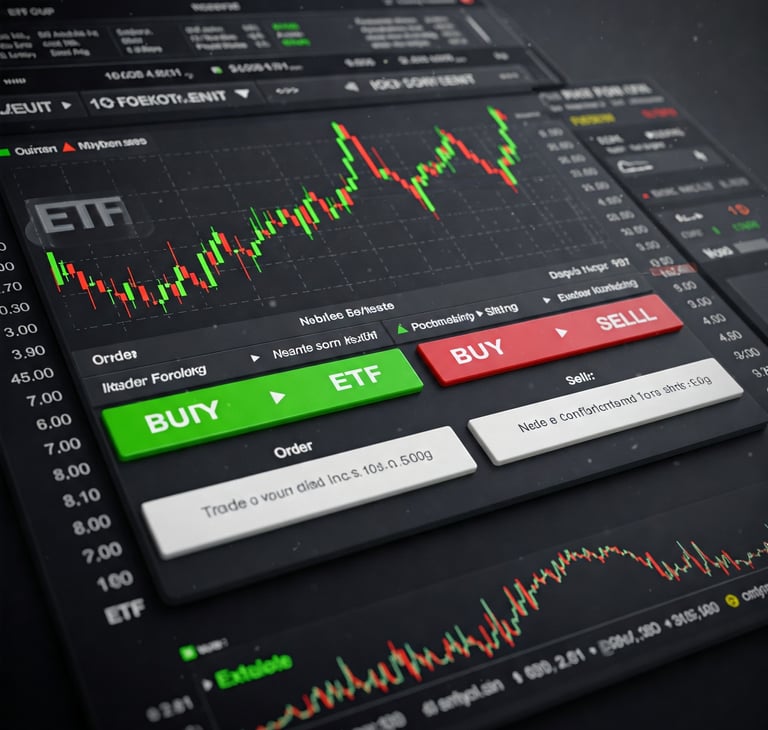

Although ETFs (exchange-traded funds) are generally easier to buy and sell than individual stocks or mutual funds, they still face certain liquidity challenges. The ease of trading an ETF largely depends on the liquidity of the underlying stocks and bonds it holds. Popular ETFs that track major indices, such as the Nifty 50, benefit from high liquidity due to the large trading volumes of the well-known companies they include, resulting in tighter bid-ask spreads and smoother transactions. In contrast, smaller or more specialized ETFs—such as those tracking less widely followed indexes—often experience lower trading volumes, which can result in wider price discrepancies between buyers and sellers, making trading less efficient. Factors like slow settlement processes, hedging constraints, and limited market maker support can further contribute to inefficient ETF trading and price deviations from their net asset value. However, India’s ETF market is expanding, and ongoing regulatory improvements along with increased institutional participation are expected to enhance liquidity and market efficiency soon.
Flexibility


ETFs are highly versatile investment vehicles that combine the benefits of diversification with the flexibility of real-time trading. Unlike mutual funds, ETFs can be bought and sold at market prices throughout the trading day, enabling investors to react quickly to changing market conditions—an advantage that is especially valuable during periods of volatility. Their structure also makes them a cost-effective choice, as they typically have lower operational expenses due to reduced administrative overhead. Additionally, ETFs are known for their tax efficiency; capital gains taxes are generally only incurred when shares are sold, rather than being distributed throughout the year as with mutual funds. This combination of flexibility, low costs, and tax advantages makes ETFs an attractive option for a wide range of investors.
Diversification
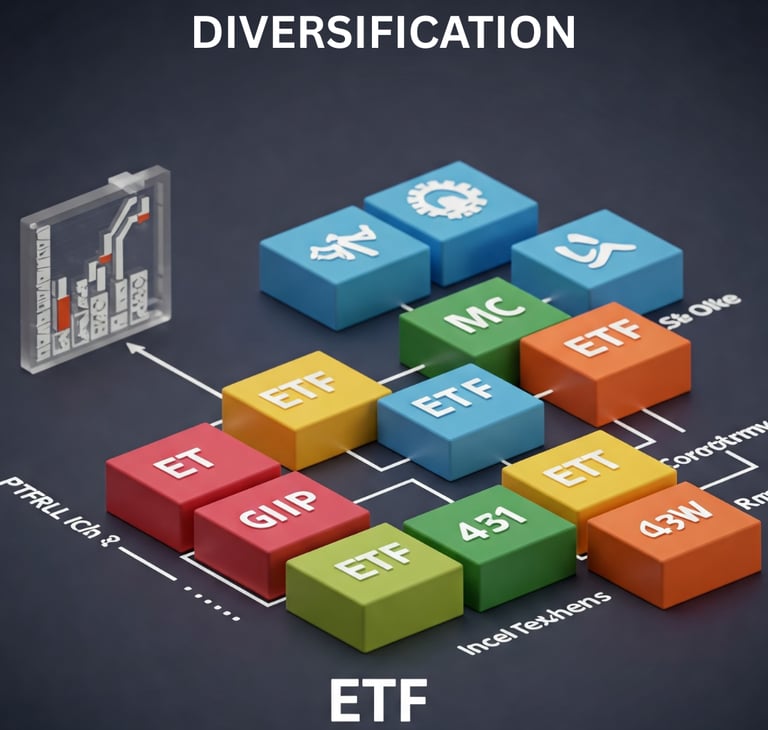

ETFs provide outstanding diversification by offering exposure to a broad range of securities, which helps minimize the risk associated with individual stock volatility. For example, an ETF tracking the Nifty 50 in India spreads investments across 50 leading large-cap companies from sectors such as banking, IT, and energy, reducing dependence on the performance of any single stock. This structure allows investors to access a wide portfolio, including equities, bonds, commodities, or even international markets, without the need to purchase each security individually. As a result, ETFs make it possible to build balanced portfolios that are both liquid and transparent while reducing concentration risk and providing flexibility across various asset classes, regions, and industries. Their passive management approach keeps costs low, making diversification affordable even for small investors, and their ease of trading on stock exchanges further enhances flexibility and accessibility
Cost Efficiency


Compared to actively managed mutual funds, exchange-traded funds (ETFs) are significantly more cost-effective due to their lower expense ratios. Most ETFs are passively managed, tracking a specific index rather than relying on a team of analysts and portfolio managers, which greatly reduces their operating costs. For example, ETF expense ratios can be as low as 0.16%–0.35%, while actively managed mutual funds often charge 0.66%–2% or more. This cost advantage is further enhanced by the unique creation and redemption process of ETFs, which minimizes capital gains distributions and administrative fees for investors. Many brokerage platforms also offer commission-free ETF trading, making them even morea affordable. As a result, ETFs’ low costs and tax efficiency allow investors to retain a larger portion of their returns, making them an attractive choice for cost-conscious investors.
Tax Efficiency
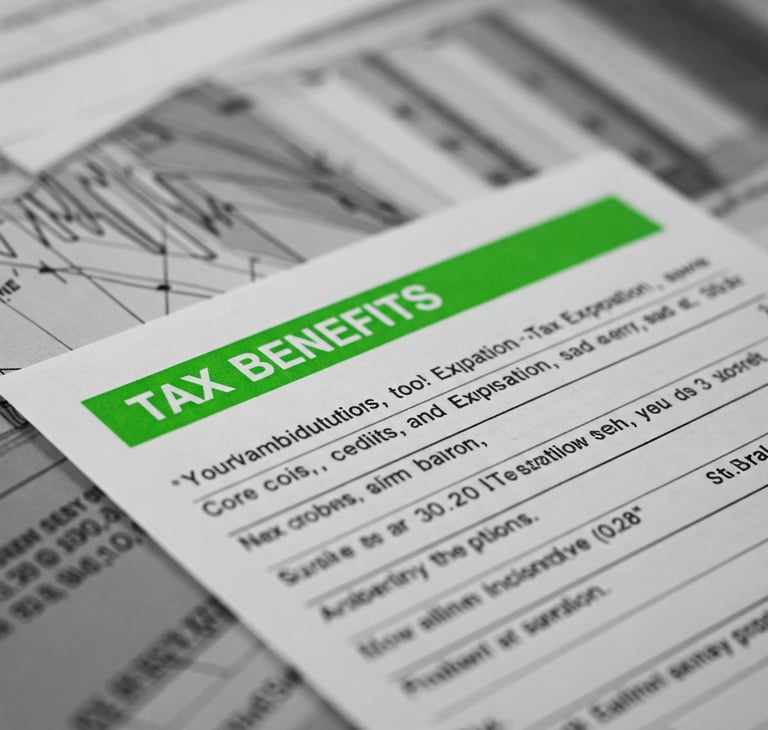

ETFs are considered highly tax-efficient investment vehicles due to their unique structure. When ETFs need to adjust their holdings, they typically use an in-kind exchange process with large institutional investors, swapping securities directly instead of selling them on the open market. This mechanism helps avoid triggering taxable capital gains, unlike mutual funds, which often generate taxable events for investors when they buy or sell securities within the fund. As a result, ETFs—especially those that track indices and have low portfolio turnover—rarely distribute capital gains to investors, so you generally only owe taxes when you sell your ETF shares. If you hold ETF shares for more than a year, any profits are taxed at the lower long-term capital gains rate, further enhancing their tax efficiency. Even actively managed ETFs benefit from this structure, making them more tax-efficient than traditional mutual funds. In India, while ETFs follow standard tax rules, their design allows investors to defer taxes until they sell, helping them retain more of their returns over time
Transparency


ETFs are generally more transparent than mutual funds because they disclose their holdings on a daily basis, allowing investors to see exactly what assets they own at any given time. This level of visibility helps investors make well-informed decisions, particularly during periods of market volatility when knowing your exact exposure is crucial. In contrast, mutual funds often provide updates on their holdings less frequently—sometimes only monthly or quarterly—and may not always share complete details, which can leave investors in the dark about sudden changes in strategy or unintentional concentration in certain stocks. While some actively managed ETFs may also limit the frequency of their disclosures to protect proprietary strategies, they still offer other tools and mechanisms to maintain trading transparency and ease.
Index Tracking
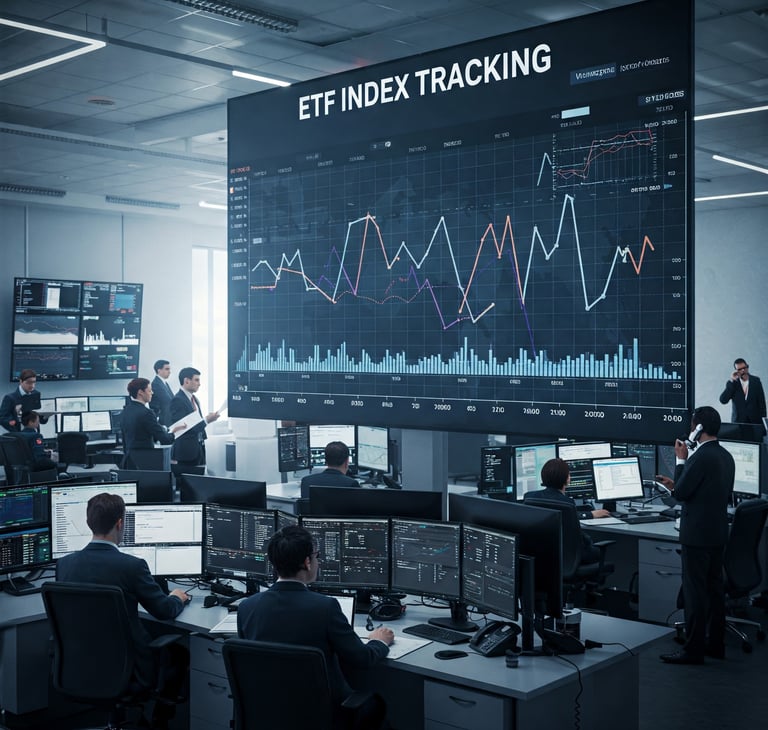

ETF index tracking refers to how closely an exchange-traded fund mirrors the performance of its chosen benchmark index. While ETFs aim to replicate their target index, differences can arise due to factors like management fees, transaction costs from rebalancing, and holding cash, all of which contribute to what’s known as tracking difference—the gap between the ETF’s actual return and that of the index. Tracking error, on the other hand, measures the consistency of this gap over time and is typically calculated as the standard deviation of the return differences. Other influences, such as timing delays during index adjustments and securities lending, can also affect an ETF’s ability to precisely follow its benchmark. Although these deviations are usually small, they can impact long-term returns, making it important for investors to regularly monitor both the ETF’s performance and its tracking of the index.
Ways To Start Investing In ETFs.
Understand ETFs
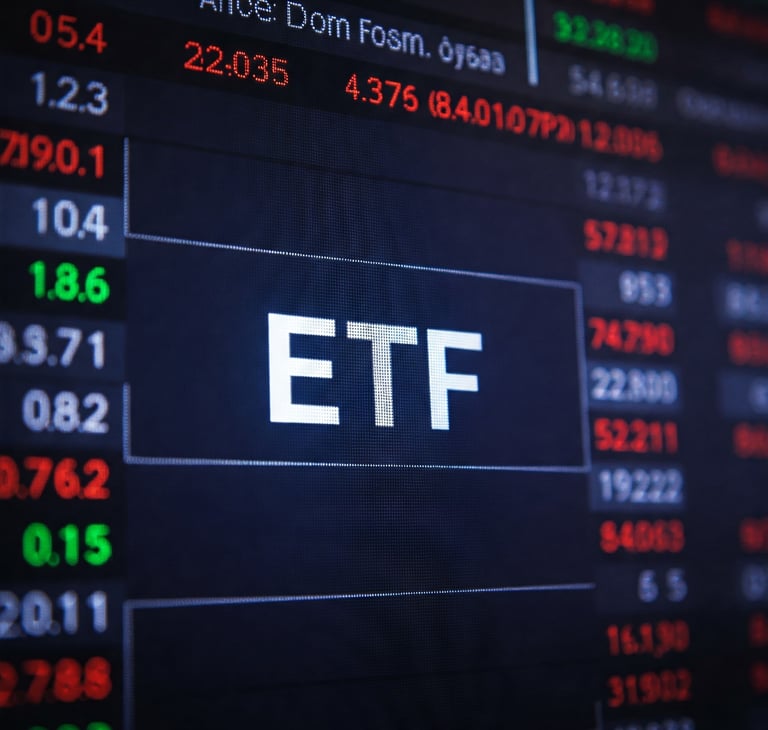

If you’re considering starting your investment journey with exchange-traded funds (ETFs), it’s essential to understand how they work and what makes them appealing. ETFs are popular investment vehicles that blend the advantages of mutual funds and individual stocks, offering flexibility in trading, lower costs, and built-in diversification. By investing in a single ETF, you can gain exposure to a broad range of securities—such as stocks, bonds, or commodities—which helps spread your risk and reduces reliance on the performance of any one asset. One of the key benefits of ETFs is their low expense ratios, as most are passively managed and simply track specific indexes, resulting in lower management fees compared to traditional mutual funds. This cost efficiency means you can keep more of your returns over time. Additionally, since ETFs are traded on stock exchanges throughout the day, you have the flexibility to buy and sell shares at real-time market prices, allowing you to respond quickly to market movements and manage your investment strategy more actively. By learning about the different types of ETFs—whether they focus on specific industries, asset classes, or investment strategies—you can better align your choices with your risk tolerance and financial goals. Furthermore, ETFs are generally more tax-efficient than mutual funds because their unique structure often results in fewer taxable capital gains distributions.
Choose the Right ETF
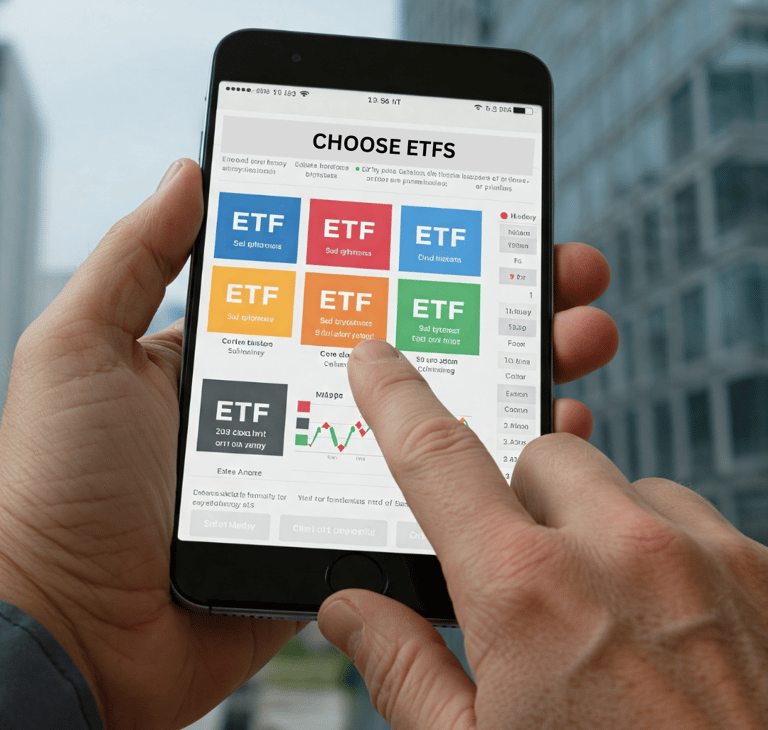

Selecting the right exchange-traded fund (ETF) is essential for investment success, as it directly influences your overall strategy and financial goals. With a wide range of ETFs available—each focusing on different sectors, asset classes, or market indices—it’s important to choose one that aligns with your specific objectives and risk tolerance. Some ETFs target particular industries or themes, while others track broad market indices, allowing you to diversify your portfolio effectively. Diversification reduces risk and can enhance potential returns by spreading investments across various assets. Cost is another critical consideration; ETFs typically have lower expense ratios than mutual funds, so comparing fees can help you retain more of your long-term gains. Liquidity and trading convenience also matter, as ETFs with higher trading volumes offer easier buying and selling throughout the day. Evaluating an ETF’s tracking error and historical performance helps ensure it closely follows its benchmark index, which is especially important for passive investors seeking reliable returns. Additionally, reviewing the reputation of the ETF provider and independent analyst ratings can provide valuable insights. By carefully considering exposure, costs, performance, and how well the ETF fits your investment goals, you can make informed decisions that enhance your portfolio and support your path to financial success.
Decide on Your Investment Strategy


Selecting your investment approach is essential when starting to invest in exchange-traded funds (ETFs), as it lays the foundation for achieving your financial goals. Whether your focus is on income, growth, or a combination of both, a well-crafted investment plan helps clearly define your objectives. Understanding your risk tolerance is crucial in choosing ETFs that align with your comfort level regarding market volatility. This initial step ensures that your investments remain flexible enough to adapt to changes in your goals or market conditions, while also fitting your current financial situation. Moreover, having a defined strategy allows you to navigate the wide variety of ETFs available—from industry-specific and thematic funds to broad-market options—and select those that best complement your overall portfolio. For example, if your aim is long-term growth, you might prioritize equity ETFs tracking major indices, whereas if income is your goal, bond or dividend-focused ETFs may be more suitable. This approach helps you build a diversified portfolio tailored to your unique needs. Finally, a clear investment plan enhances your ability to manage risk and make informed decisions. By regularly reviewing and adjusting your strategy based on performance and market trends, you can optimize your portfolio’s success over time. In the fast-changing world of investing, such proactive management is particularly important.
Monitor Your Investments


Starting to invest in exchange-traded funds (ETFs) requires regular attention to your holdings for several key reasons. Consistently monitoring your investments keeps you updated on market developments and the performance of your ETFs, enabling you to make timely decisions that optimize your portfolio and manage risks effectively. Factors such as economic changes and geopolitical events continuously influence the financial landscape, so staying vigilant helps you respond quickly and avoid significant losses. This proactive approach ensures your investment strategy remains aligned with your financial goals and risk tolerance, as some ETFs may outperform others or new opportunities may emerge that better suit your objectives. By comparing your ETFs’ performance against relevant benchmarks and alternative investments, you can make informed adjustments to your portfolio, such as reallocating assets or capitalizing on emerging trends. Additionally, reviewing the fees and expenses associated with your ETFs is crucial, as these costs can significantly affect your overall returns. Regular evaluation helps identify underperforming or overpriced funds, allowing you to make smart changes that enhance your portfolio’s efficiency.
Consider Diversification


When starting to invest in exchange-traded funds (ETFs), diversification is crucial because it helps reduce risk while enhancing potential returns. By spreading your investments across a variety of assets, you minimize the impact that poor performance from any single investment can have on your overall portfolio. ETFs inherently provide this diversification by holding a broad range of securities, often mirroring an underlying index or asset class. This means that even if one stock or sector underperforms, the positive performance of other assets within the ETF can help balance your investment’s overall results. Diversification also grants investors access to a wider array of market opportunities without the need to buy individual stocks or bonds. ETFs make it easy to invest across multiple industries, geographic regions, or asset classes within a single fund, offering the flexibility to build a portfolio that aligns with your risk tolerance and financial goals. For example, an ETF with a balanced focus on growth and income might include a mix of domestic and international equities and bonds. Maintaining a diversified portfolio can help protect against significant losses during volatile market periods, as different asset classes tend to perform differently depending on economic conditions.
Ways To Find Good ETFs
Define Your Investment Goals


To find the best exchange-traded funds (ETFs) that align with your financial goals, it is essential to have a clear understanding of your investment objectives. Whether you are seeking long-term growth, income generation, or capital preservation, defining these goals helps you focus on ETFs that suit your needs. For example, ETFs tracking high-growth industry indices may be suitable for growth-oriented investors, while dividend-focused ETFs might better serve those looking for steady income. This clarity ensures that your investments have a purpose and complement your overall financial plan. Additionally, having well-defined goals makes it easier to assess your risk tolerance, as different ETFs carry varying levels of risk based on their underlying assets and market exposure. Investors with low risk tolerance might prefer bond ETFs or those focused on stable blue-chip companies, whereas those comfortable with higher risk may consider sector-specific or thematic ETFs that offer greater potential returns but also higher volatility. Setting clear investment objectives also facilitates ongoing portfolio management, allowing you to regularly evaluate whether your current ETF holdings remain suitable as market conditions and personal circumstances evolve. This disciplined approach to tracking and adjusting your portfolio can lead to better decision-making and improved long-term investment results.
Research Different ETFs
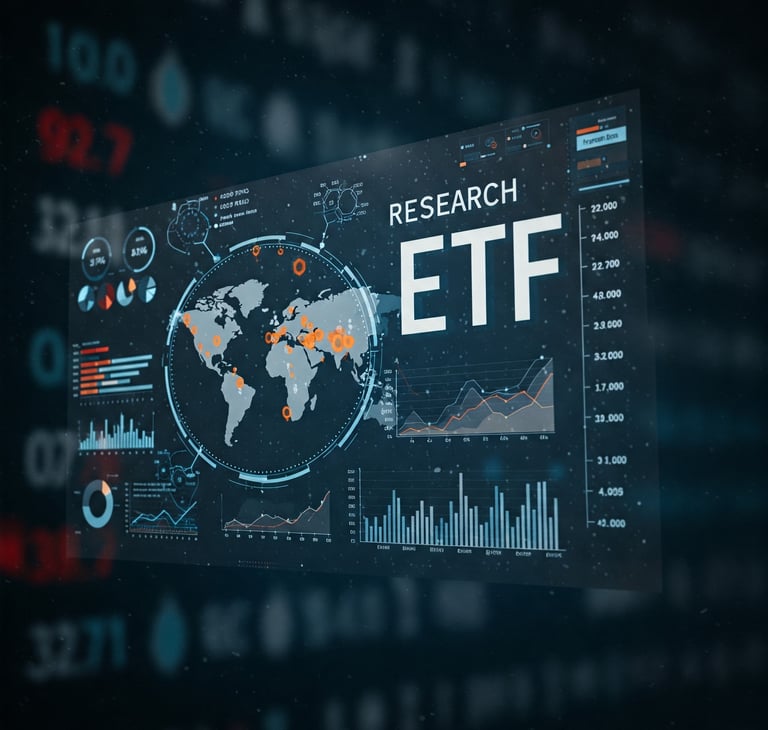

Investigating a variety of exchange-traded funds (ETFs) is essential for identifying the assets that best align with your financial goals. With so many different ETFs available—each offering unique features and strategies—understanding their differences enables you to make informed choices tailored to your needs. Whether your investment priorities are diversification, growth, or income, exploring several options allows you to select funds that match both your objectives and your risk tolerance, resulting in a more personalized investment approach. It’s also important to analyze an ETF’s underlying components to assess its risk profile and performance potential. By knowing which stocks or assets make up each ETF, you can evaluate how the fund might perform under various market conditions and identify any sector or geographic concentrations that could increase risk. For example, an ETF heavily weighted in a single industry may be more exposed to sector-specific volatility. Careful research helps you avoid overexposure to particular assets and maintain a diversified portfolio. Additionally, investigating ETFs can uncover differences in expense ratios and other fees, which can have a significant impact on your long-term returns. Lower costs generally translate to higher net gains over time, so comparing fees is a crucial part of the selection process.
Check Performance History
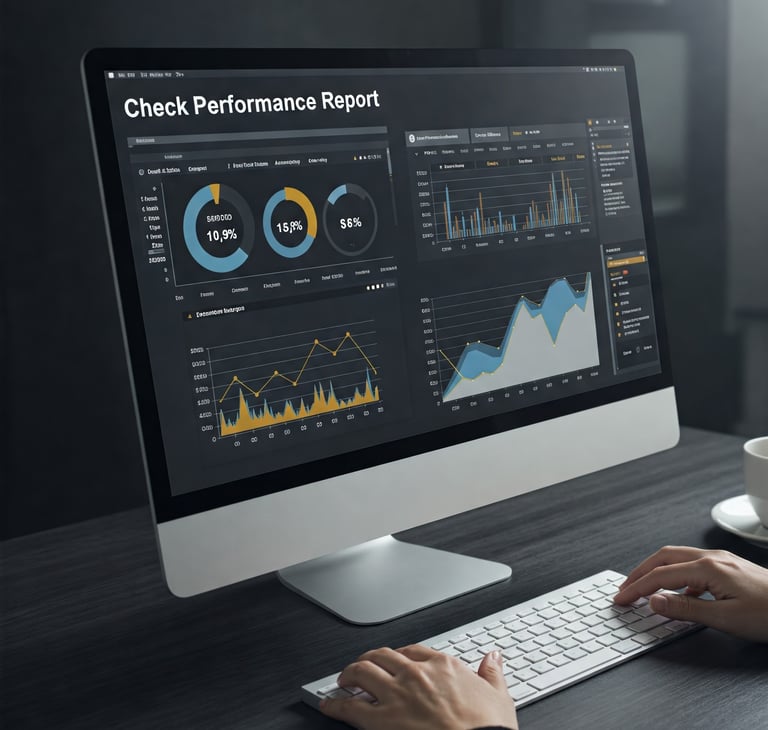

Analyzing the historical performance of exchange-traded funds (ETFs) is essential for identifying promising investment options, as it provides valuable insights into a fund’s long-term consistency and success. Reviewing an ETF’s past returns allows investors to evaluate how reliably it has tracked its benchmark index, which is especially important for passive investors who expect the ETF to closely follow the market segment it represents. Consistent positive returns over various periods demonstrate the fund’s ability to withstand market fluctuations and meet its investment objectives. Comparing the performance of ETFs within the same sector or category can also help identify those that have outperformed their peers, guiding investors toward funds that better suit their strategies. For example, if two ETFs track the same index but one delivers higher returns with lower volatility, it may be the preferred choice. Additionally, examining historical data can reveal potential concerns such as high tracking error, which measures how closely an ETF’s returns align with its benchmark. A large tracking error suggests the ETF may not accurately replicate the index, potentially leading to subpar performance. While many ETFs effectively track their benchmarks, some may underperform or exhibit greater volatility, so it is important to assess both returns and risk-adjusted performance. By considering an ETF’s historical returns, comparing it with similar funds, and monitoring tracking accuracy, investors can make well-informed decisions and select ETFs that align with their financial goals and risk tolerance.
Evaluate Expense Ratios
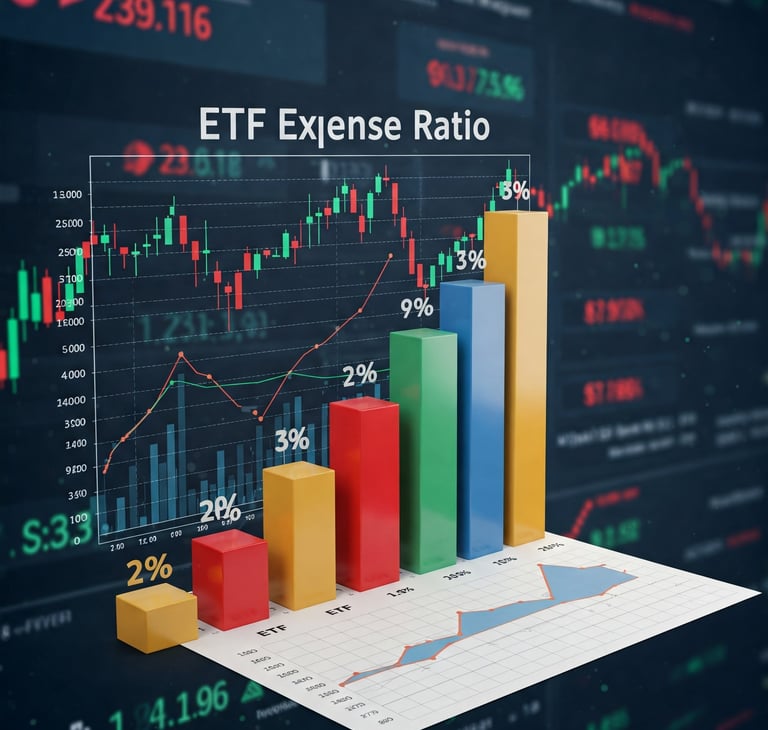

When searching for reliable exchange-traded funds (ETFs), it’s crucial to pay close attention to expense ratios, as they have a direct impact on your investment returns. The expense ratio represents the annual fees charged by the fund to cover operations such as management, administration, and marketing. These fees are deducted from the fund’s returns, meaning that even a seemingly small difference in expense ratios, such as between 0.5% and 1.5%, can significantly affect your investment’s value over time. This is especially important for long-term investors, as high fees can erode the compounding effect of your returns. By prioritizing ETFs with lower expense ratios, you can maximize your investment growth and ensure more of your money remains invested and working for you. It’s also wise to compare the expense ratios of similar ETFs to identify more cost-effective options that align with your investment strategy. Many index ETFs now offer extremely competitive expense ratios, often much lower than those of actively managed mutual funds.
Look at Liquidity
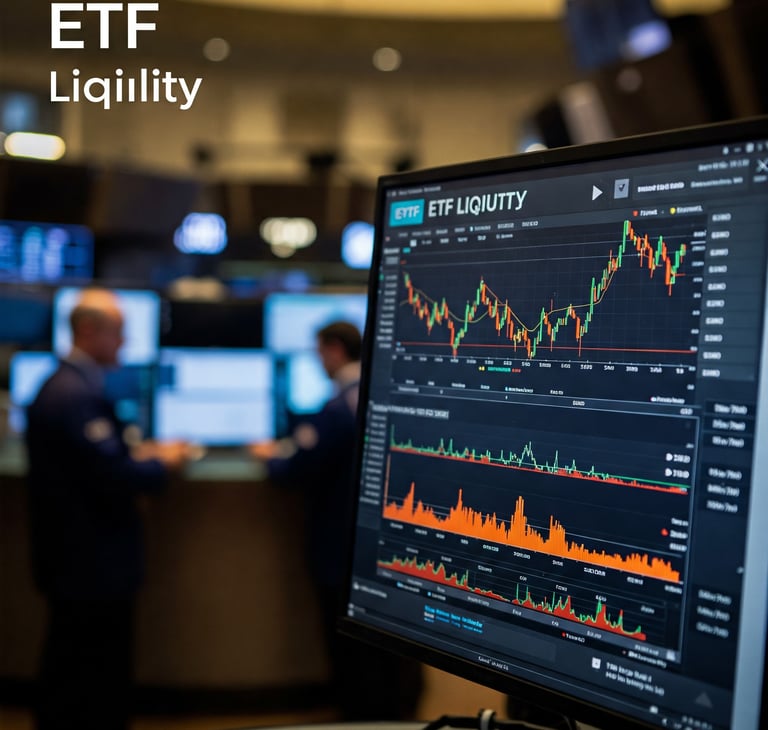

When evaluating quality exchange-traded funds (ETFs), liquidity is a crucial factor because it directly affects how easily you can buy or sell shares without significantly impacting the price. Liquidity refers to the ease with which ETF shares can be traded in the market, influencing your trading costs and the efficiency of your transactions. Highly liquid ETFs enable quick entry or exit at prices that closely reflect the intrinsic value of their underlying assets, which is particularly important during volatile market conditions when timely trades can help you capitalize on opportunities or mitigate losses. The liquidity of an ETF depends on both its own trading volume and the liquidity of the securities it holds. ETFs composed of large-cap stocks or other highly liquid assets generally exhibit greater overall liquidity. However, even ETFs with lower trading volumes can be liquid if their underlying assets are easy to trade, thanks to the creation and redemption process that helps maintain price stability. When assessing ETF liquidity, it’s important to consider not only average daily trading volume but also the liquidity of the underlying holdings and the bid-ask spread. Narrow spreads indicate high liquidity, allowing trades closer to the ETF’s net asset value and reducing transaction costs. Prioritizing ETFs with strong liquidity characteristics helps you avoid the pitfalls of low-liquidity funds, such as wider spreads and higher trading expenses, resulting in a more efficient trading experience and better control over your investment outcomes.
Review Holdings and Diversification
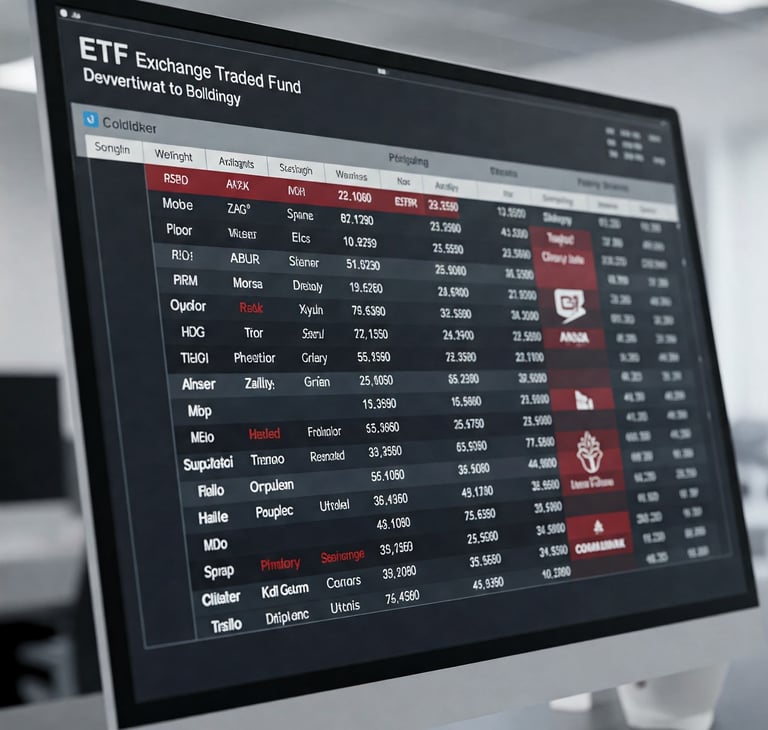

Examining the holdings and diversification of exchange-traded funds (ETFs) is crucial for selecting suitable investments, as it offers important insights into a fund’s risk profile and potential returns. By understanding the specific assets within an ETF, investors can determine if the fund aligns with their risk tolerance and investment goals. For instance, an ETF concentrated in large-cap stocks may provide strong growth potential but also carries higher risk, whereas a more diversified ETF spanning multiple industries can help reduce risks associated with individual stocks or sectors, leading to a more stable investment experience. Diversification, a key investment principle, naturally comes with ETFs since they combine various securities such as stocks, bonds, or commodities, which helps minimize the impact of poor performance from any single asset. Reviewing an ETF’s diversification strategy—whether it focuses on different asset classes, geographic regions, or market capitalizations—enables investors to assess how well the fund fits into their overall portfolio. Additionally, understanding this strategy can reveal potential market risks and opportunities; some ETFs may target emerging markets or specific sectors with growth potential, allowing investors to benefit from trends while managing risk through diversification. Conversely, ETFs heavily concentrated in one industry or region may expose investors to increased volatility and possible losses. Therefore, regularly monitoring ETF holdings and evaluating their diversification is essential to building a resilient portfolio that can withstand market fluctuations and aligns with your financial objectives.
Use Online Tools
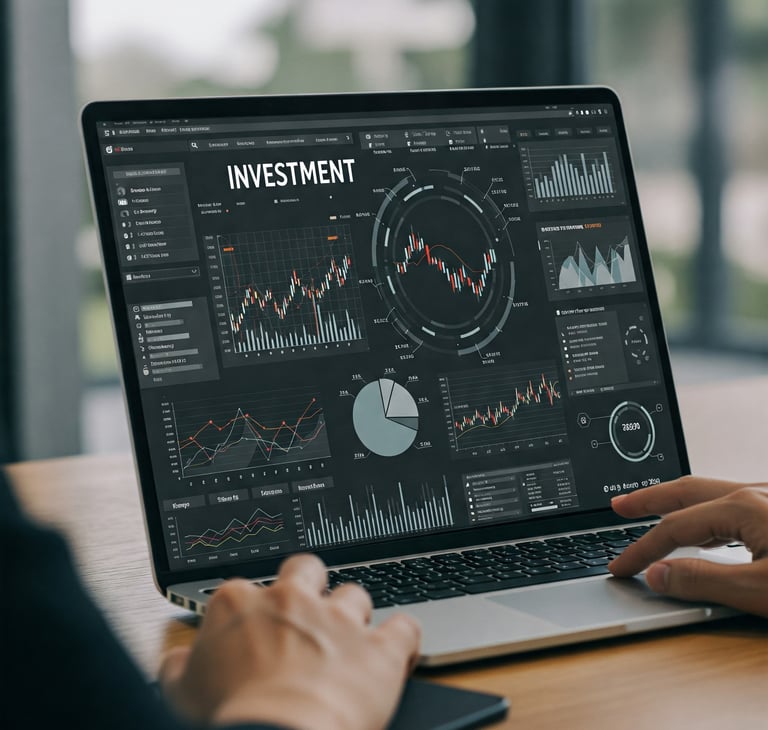

Using online resources to find high-quality exchange-traded funds (ETFs) is essential because they offer valuable data and tools that can help you make better investment decisions. Platforms like StockEdge allow investors to analyze ETFs by sector, benchmark index, expense ratios, performance history, and asset allocation, making it easier to identify funds that align with specific investment goals. These tools streamline and speed up the process of selecting the best ETFs by providing detailed comparisons and insights. Additionally, many online resources provide up-to-date information on market trends, news, and economic data, which are crucial for understanding the broader environment in which an ETF operates. This knowledge enables you to respond quickly to market shifts and adjust your investment strategy accordingly. For example, if a particular sector is gaining momentum due to favorable economic conditions, you can identify ETFs focused on that area to capitalize on growth opportunities. Furthermore, numerous online courses and educational materials help investors learn key concepts such as risk management, liquidity, and diversification, enhancing their overall understanding of ETFs and investing. By utilizing these resources and learning tools, you can reduce investment risks and develop a more solid, well-informed investment plan that aligns with your financial goals.
Stay Updated on Market Trends


Keeping up with market trends is essential for finding quality exchange-traded funds (ETFs), as it enables investors to make informed decisions based on current economic conditions and market dynamics. The financial landscape is constantly influenced by factors such as economic data, interest rates, geopolitical events, and technological advancements. By staying aware of these trends, investors can identify asset classes or industries that are experiencing growth and may offer stronger potential returns. For example, investing in ETFs that target specific sectors can be a smart move if those areas are expected to benefit from regulatory changes or technological innovations. Understanding market trends also helps investors evaluate how particular ETFs perform relative to the broader economy, recognizing that an ETF that excelled during a bull market may not perform as well during a downturn. Analyzing how different sectors respond to various market conditions allows investors to allocate their portfolios more strategically, ensuring that their investments remain aligned with prevailing market realities. Moreover, staying updated on market developments supports effective risk management, as investors can adjust their portfolios in response to rising volatility or potential downturns. This proactive approach enhances the overall resilience of an investment strategy and helps mitigate risks.
